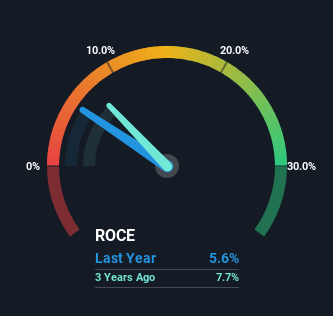Polaris Renewable Energy (TSE:PIF) Could Be Struggling To Allocate Capital
If we want to find a potential multi-bagger, often there are underlying trends that can provide clues. In a perfect world, we'd like to see a company investing more capital into its business and ideally the returns earned from that capital are also increasing. Put simply, these types of businesses are compounding machines, meaning they are continually reinvesting their earnings at ever-higher rates of return. However, after investigating Polaris Renewable Energy (TSE:PIF), we don't think it's current trends fit the mold of a multi-bagger.
What Is Return On Capital Employed (ROCE)?
For those that aren't sure what ROCE is, it measures the amount of pre-tax profits a company can generate from the capital employed in its business. The formula for this calculation on Polaris Renewable Energy is:
Return on Capital Employed = Earnings Before Interest and Tax (EBIT) ÷ (Total Assets - Current Liabilities)
0.056 = US$28m ÷ (US$526m - US$32m) (Based on the trailing twelve months to September 2023).
Therefore, Polaris Renewable Energy has an ROCE of 5.6%. In absolute terms, that's a low return, but it's much better than the Renewable Energy industry average of 3.5%.
Check out our latest analysis for Polaris Renewable Energy
Above you can see how the current ROCE for Polaris Renewable Energy compares to its prior returns on capital, but there's only so much you can tell from the past. If you'd like to see what analysts are forecasting going forward, you should check out our free report for Polaris Renewable Energy.
What The Trend Of ROCE Can Tell Us
When we looked at the ROCE trend at Polaris Renewable Energy, we didn't gain much confidence. To be more specific, ROCE has fallen from 8.8% over the last five years. However, given capital employed and revenue have both increased it appears that the business is currently pursuing growth, at the consequence of short term returns. And if the increased capital generates additional returns, the business, and thus shareholders, will benefit in the long run.
What We Can Learn From Polaris Renewable Energy's ROCE
While returns have fallen for Polaris Renewable Energy in recent times, we're encouraged to see that sales are growing and that the business is reinvesting in its operations. And the stock has followed suit returning a meaningful 55% to shareholders over the last five years. So should these growth trends continue, we'd be optimistic on the stock going forward.
One final note, you should learn about the 4 warning signs we've spotted with Polaris Renewable Energy (including 2 which can't be ignored) .
If you want to search for solid companies with great earnings, check out this free list of companies with good balance sheets and impressive returns on equity.
Have feedback on this article? Concerned about the content? Get in touch with us directly. Alternatively, email editorial-team (at) simplywallst.com.
This article by Simply Wall St is general in nature. We provide commentary based on historical data and analyst forecasts only using an unbiased methodology and our articles are not intended to be financial advice. It does not constitute a recommendation to buy or sell any stock, and does not take account of your objectives, or your financial situation. We aim to bring you long-term focused analysis driven by fundamental data. Note that our analysis may not factor in the latest price-sensitive company announcements or qualitative material. Simply Wall St has no position in any stocks mentioned.

